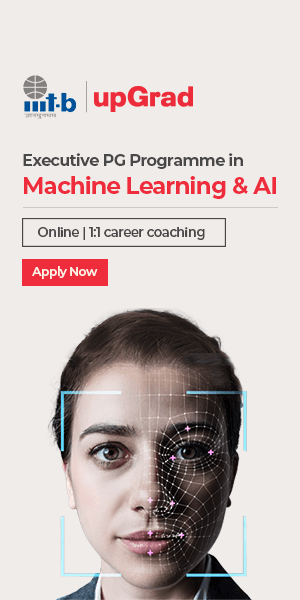Introduction
Machine learning (ML) is one of the most popular skills for programmers. According to a report published by Indeed in 2019, machine learning engineering was the highest in-demand AI job in the US. Some sectors that widely use machine learning technology are finance, banking, healthcare, investment, marketing, manufacturing, cybersecurity, and transportation. This blog will help you understand the concept of machine learning and its different types.
What is Machine Learning?
Machine learning is a modern technology that uses data to predict accurate outcomes and enhance the performance of a device. In simple words, machine learning technology enables computers to use historical data and predict outcomes in similar situations without being explicitly programmed. The technology works similarly to the human brain. The algorithm observes the data provided, analyzes it, and records data patterns. The algorithm predicts outcomes based on previous patterns when a new dataset is provided. The concept is termed machine learning because the machine learns from the information and delivers results.
Get Machine Learning Certification from the World’s top Universities. Earn Masters, Executive PGP, or Advanced Certificate Programs to fast-track your career.
Different Types of Machine Learning
There are 14 different types of machine learning techniques based on the type of training data provided to the device and how data gets utilized by the algorithm. Let us discuss the different types of machine learning.
1. Supervised Learning
Supervised learning is the most popular type of machine learning that uses labeled data for classification. We use a training dataset with different inputs and outputs to teach the algorithm in supervised learning. The algorithm then predicts favorable outcomes based on the input and output data already provided.
We use data for three purposes in supervised learning; training, validation, and testing. First, we gather labeled data to train the ML algorithm. During the second stage, we use different data sets to validate the correct performance of the algorithm. Lastly, the algorithm is tested in the real world.
2. Unsupervised Learning
Contrary to supervised learning, we use untagged or unlabeled data in unsupervised learning. In this type of machine learning algorithm, we do not have to supervise the algorithm by providing input and output datasets. The algorithm itself discovers hidden patterns in the data sets.
There are four types of unsupervised learning techniques; clustering, anomaly detection, association mining, and latent variable models. In clustering, the algorithm splits the datasets into different groups based on some similar properties. We use anomaly detection to find unusual activity in the dataset. Association mining technique groups frequently occurring data items together.
Our AI & ML Programs in US
| Master of Science in Machine Learning & AI from LJMU and IIITB | Executive PG Program in Machine Learning & Artificial Intelligence from IIITB |
| To Explore all our courses, visit our page below. | |
| Machine Learning Courses | |
3. Semi-supervised Learning
Semi-supervised learning is a blend of both supervised and unsupervised machine learning techniques. We use both labeled and unlabeled data to train the algorithm. Labeled data is used in small quantities, and unlabeled data is used in large quantities. Semi-supervised learning technique is used to perform intensive tasks that are difficult to carry out by supervised or unsupervised learning alone. First, we use the unsupervised learning algorithm to cluster similar data. Next, the unlabeled data is classified with the help of existing labeled data.
Some practical applications of semi-supervised learning include classifying content available on the Internet, speech recognition, and DNA classification.
4. Reinforcement Learning
Reinforcement learning uses the concept of rewards and punishment. The algorithm associates favorable or pleasant events as rewards and construes unpleasant events as punishment. The reward and punishment concept strengthens the algorithm and learns to use the best possible behavior over time. When we enter information, the algorithm takes suitable action to maximize the reward.
5. Self-supervised Learning
It is a subset of unsupervised learning. As the name suggests, self-supervised learning is a type of machine learning in which the algorithm seeks input from unlabeled data on its own and delivers results. Since it is challenging to obtain labeled data, programmers often use unlabeled, readily available data. In self-supervised learning, the data provides supervision to the algorithm. The machine obtains labels from the data itself and predicts inputs. Self-supervised learning is one of the most data-efficient machine learning techniques.
6. Multi-instance Learning
It is a type of supervised learning technique with a slight variation. Multi-instance learning technique uses weakly labeled data. It means that data has incomplete tags, and only the instances in a bag are assigned labels. The algorithm uses a binary concept. It labels the bag positive if there is one positive instance and labels it negative if at least one instance is negative.
Multi-instance type of machine learning is mainly used in pathologies as it can quickly determine malignant cells in the sample. The algorithm considers malignant cells negative instances.
Popular AI and ML Blogs & Free Courses
7. Online Learning
In online learning, the algorithm uses the available data to update the model once an observation is made. The online learning technique is used when several observations are present in a short span.
8. Active Learning
Active learning is a type of supervised machine learning which uses a small dataset with only relevant data points. We prioritize data in this type of machine learning. First, we need to label a small sample of data manually. The next step is training the algorithm according to the labeled data. Once the model is trained, we can use it to determine the class of unlabeled data points.
9. Ensemble Learning
Ensemble means to combine things and look at them together as a whole. Therefore, ensemble learning is a type of machine learning where the algorithm combines the predictions from different models for better results. There are three different models in ensemble learning:
- Bagging- It involves adding different predictions to the sample tree and taking out an average of all the predictions. It uses samples of the same data set.
- Stacking- In stacking, we use different models of the same data set. However, we also use another model to determine how the predictions can be combined.
- Boosting- In this technique, we arrange the predictions in a sequence and calculate the weighted average of all predictions.
9. Transfer Learning
In the transfer learning technique, we transfer the elements of a pre-trained model to the new model. This technique is used when two models are created to perform similar tasks. Transfer learning is one of the most cost and time-efficient types of machine learning.
10. Multi-task Learning
Multi-task learning is a type of machine learning in which the machine learns several tasks simultaneously. Instead of using various models to carry out different tasks, we can train one model to multi-task and perform multiple takes at the same time.
11. Inductive Learning
We create a generalized rule in the form of IF-THEN for the dataset in inductive learning. This technique works in the format of ‘If an event occurs, then this happens’. Inductive learning is used to derive a function from the given data. Some practical applications of inductive learning include:
- Credit approval (If a customer has A property, then B is whether credit will be approved or not).
- Disease diagnosis (If a patient has A symptoms, then the patient has B disease).
12.Transductive Learning
Transduction is the process of converting an element from one form to another. In transductive learning, we do not have to model the training data. The algorithm directly uses data to predict information by deriving values of an unknown function from the given dataset.
13. Deductive Learning
Deductive learning is a machine learning technique used to analyze data and produce inferences from the same. In deductive learning, we train the algorithms to use provably correct knowledge. It helps the programmers realize that particular information is correct and has been derived earlier.
Conclusion
Many companies are using ML to enhance customer satisfaction and increase customer retention by creating personalized chatbots. The technology also helps optimize supply chain processes and automate financing processes in organizations. Top companies in the US like Meta, Netflix, Google, Twitter, Pinterest, and other organizations are using machine learning to automate work processes and perform complex tasks in a minimum time frame. This is why machine learning engineers are in great demand in the US.
ML has become one of the most lucrative career options today due to better salaries and growth opportunities. You can pursue an Master of Science in Machine Learning and Artificial Intelligence from upGrad to gain advanced knowledge of machine learning and acquire relevant skills.




